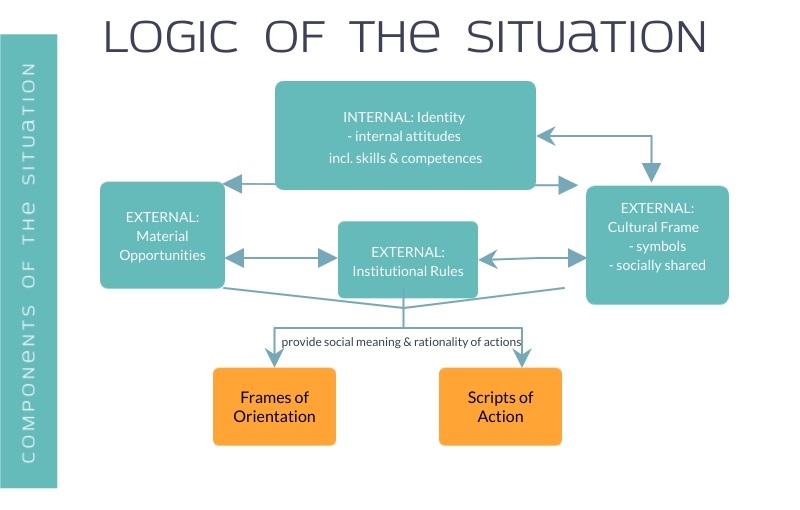Rational Choice Theory: From situation to action
Introduction to Rational Choice Theory (RCT)
Decision making can be as simple as switching on the coffee machine in the morning – a routine we may not even notice. In the next moment, it can be as complex as weighing all the pros and cons of buying a house in the city versus on the country side and not finding a clear winner. Every day we take 35000 actions, all based on conscious or subconscious decisions. These decisions lie on a spectrum from hardly noticeable to driving us nuts. Is there a qualitative difference between these types of decisions? And how do we actually make decisions?

Rational Choice Theory (RCT)[1-6] is the, in my opinion, best contemporary theory, which can give you all the answers.
“Rational???” – I can hear you say now … Followed by:
“Absolutely, *my* decisions are always rational!”
You – the reader
or
“What? No … Humans are inherently irrational!”
Well, that depends on the definition of what rational means, but first things first.
Put yourself in the position of taking a specific action, like you do so many times a day. You are an actor in that situation. Now, in that situation what influences your decision? It depends on the situation of course 😉
The actor’s situation
According to RCT[1], at any point of making a decision, an actor finds himself in a situation (Fig. 1), which is comprised of 3 external & 1 internal components. The internal constituent is the identity of the actor, comprised of their values, wishes, attitudes, skills and personality. The 3 external constituents are material opportunities, institutional norms and the cultural frame relevant in the present situation:
- Material opportunities at present
Sounds like money – is it money? No, material opportunities are much more than that. In short, they are any kind of capital or resources that you find relevant for your situation. Personally, I find Bourdieu’s[7] 4 different categories of capital very useful: economic, cultural, social and symbolic capital.- Economic capital is closest to what we usually understand as capital in our daily lives. It consists of financial resources, time and material resources for one’s work, such as computers, but also facilities.
- Cultural capital includes the education, the knowledge and skills that one has attained.
- Social capital are all human resources that an actor has access to, including their co-workers, their family, friends and network.
- Symbolic capital is acquired through recognition of achievements, for example transcripts, certificates or the CV. This kind of capital is a symbol for having obtained other forms of capital.
- Institutional norms
Institutional norms set the rules for what is appropriate behaviour and define what are desirable goals. Read more on the function of and compliance with institutional norms here. As an example picture the explicit and implicit rules in your work environment or the expectations that come with having a romantic relationship (not to cheat for instance).
- Cultural reference frame
The cultural reference frame refers to symbols and shared values in our culture/ society. Symbols help to identify what (material) opportunities and restrictions apply and what alternatives are possible. As an example take the non-smoking sign. When you see that you know which rule applies: you may not smoke.

Reconstructing the relevant factors that make up an actor’s situation results in the logic of the situation. This analytical step basically delivers the reasons for an action. In that sense is every action explainable (even if it seems irrational, cruel or disagreeable). Therefore, fully understanding the situation of an actor, explains their action, whether we personally agree with it or not. Naturally, often we won’t know all the relevant factors of somebody else’s situation, but maybe this insight helps us being aware that everybody has their reasons for their actions.

Note, that some situations are lasting longer than others. For example, studying for an exam may last weeks. You may view the decisions where you sit down and study then as a sub-situation of the larger one.
Now, how does one get from situation to action?
Most of our daily decisions (tens of thousands!) are made subconsciously. We make them according to so-called scripts. Scripts are action plans in our subconscious, based on our socialization and past experiences. These routines include open slots for improvisation.

For example, imagine entering a café; you are not wondering why there are people sitting around tables chatting with each other (you would be wondering if there was sitting a naked person though, not complying to our norms that we need to be dressed in public). You don’t need to think about what to do to get your coffee, but go straight to the counter. This whole process is so automatic that you can probably do it while having a phone call. In the next step, you may have to pause that call for a second to decide which coffee to get. You do so by looking at the menu, which outlays your options by means of symbols that make up our alphabet, which you grew up with in our culture. This way you make a conscious decision within the improvisation slot of your café script (or you take whatever you take every day and don’t need to think about it). You go back to your phone call, while you are paying at the same time (because you subconsciously know you have enough economic capital for this action). Most of these actions were automated and unquestioned, performed according to your café script.
Before applying a script we have subconsciously made another decision: what frame of orientation to apply. By framing the situation, an actor defines what is important or relevant. Hence, a frame of orientation is a model of the situation, often including the definition of certain goals, which gives an actor orientation. When being home alone you’ll probably apply a different frame than throwing a party at home or having a normal day at the office.
To summarise, when we do something we first (subconsciously) choose the frame of orientation, which defines the relevant aspects of the situation (our material opportunities, the rules at present, our goals at present and the cultural contingencies). Within these frames, we have certain scripts available, which help us taking most actions without putting too much conscious effort.
Okay, now we covered most of our daily decisions, which are subconscious. However, what about our conscious decisions? The next episode on decision making will cover those :).
References [1] Esser, H., (1999), “Soziologie. Spezielle Grundlagen. Band 1: Situationslogik und Handeln“, Campus Verlag Frankfurt/New York, DOI: 10.1007/s11577-001-0109-z [2] Esser, H., (1999), “Soziologie. Spezielle Grundlagen. Band 2: Die Konstruktion der Gesellschaft“, Campus Verlag Frankfurt/ New York [3] Esser, H., (2000), “Soziologie. Spezielle Grundlagen. Band 3: Soziales Handeln“, Campus Verlag Frankfurt/ New York [4] Esser, H., (2000), “Soziologie. Spezielle Grundlagen. Band 4: Opportunitäten und Restriktionen“, Campus Verlag Frankfurt/New York, DOI: 10.1007/s11577-001-0110-6 [5] Esser, H., (2000), “Soziologie. Spezielle Grundlagen. Band 5: Institutionen“, Campus Verlag Frankfurt/New York, DOI: 10.1007/s11577-001-0112-4 [6] Esser, H., (2001), “Soziologie. Spezielle Grundlagen. Band 6: Sinn und Kultur“, Campus Verlag Frankfurt/ New York [7] Bourdieu, P., (1983), “Ökonomisches Kapital, kulturelles Kapital, soziales Kapital”, In: Kreckel R. (Ed.), “Soziale Ungleichheiten”, Sonderband 2 der Sozialen Welt, Göttingen 1983, p. 185ff.
Navigate through the episodes of the special theme The Science of Human Behaviour here:
Table of Contents
- Introduction to The Science of Human Behaviour
- Motivation: Research shows that there are 5 different types of motivation. Especially the aggregate forms – autonomous vs. controlled motivation – have a different impact on our well-being.
- Decision Making: Rational Choice Theory explains how we make our 35000 daily decisions and how social phenomena arise from our individual behaviour.
- Episode 1: From situation to action
- Episode 1.1: Institutional Norms
- Episode 2: Taking action
- Episode 2.1: Excursion: Deviant Behaviour
- Episode 3: Emergence of Social Phenomena
- Self-Organisation & Transformation: Synergetics – the meta-theory of order transitions – connects the natural sciences with the social sciences and explain what we can change and what we cannot.
- Synergetics-Dictionary
- Episode 1: Physical principles and basics
- Episode 2: The relevance of transformation
- Episode 3: The Agile Organisation
- Episode 3.1: The Synergetic Navigation System (SNS)
Written by Julia Heuritsch | Last edited: 23rd September 2022